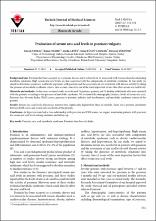Evaluation of serum uric acid levels in psoriasis vulgaris
Citation
Yılmaz, E., Tamer, E., Artüz, R. F., Külcü Çakmak, S., Köktürk, F. (2017). Evaluation of serum uric acid levels in psoriasis vulgaris. Turkish Journal of Medical Sciences, 47(2), 531-534.Abstract
Background/aim: Psoriasis has been accepted as a systemic disease and it is known to be associated with various disorders including metabolic syndrome. High serum uric acid levels are also associated with the components of metabolic syndrome. In this study, we aimed to determine serum uric acid levels in patients with psoriasis and the association of uric acid levels with disease activity by taking the presence of metabolic syndrome criteria into account, since it is one of the most important factors that affect serum uric acid levels. Materials and methods: In this cross-sectional study, we evaluated 70 psoriasis patients and 70 healthy individuals who were matched with the patients according to the presence of metabolic syndrome. We evaluated the demographic features, levels of serum uric acid, Psoriasis Area Severity Index (PASI) scores, presence of psoriatic arthritis, nail involvement, and metabolic syndrome criteria of the patients. Results: Serum uric acid levels of psoriasis patients were significantly higher than those of controls. There was a positive correlation between PASI scores and serum uric acid levels of the patients. Conclusion: As hyperuricemia had a close relationship with psoriasis and PASI scores, we suggest monitoring patients with psoriasis for serum uric acid levels during treatment and follow-up. © TÜBİTAK.


















